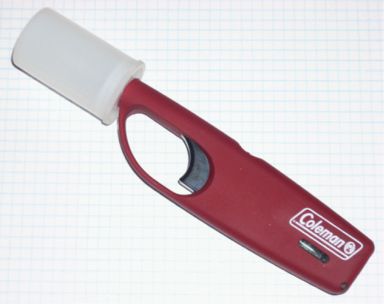
Based on SciToy's really neat "Binaca Cannon"

|
The "popper" uses a hacked long-necked fireplace lighter and a 35mm film cartridge canister to make a loud bang. It also launches the body of the film canister twenty to thirty feet. The lighter provides both the butane fuel source and the high voltage spark needed to ignite the butane. |
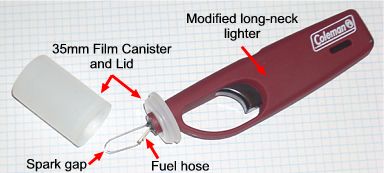 |
|
Start with a long-tipped fireplace lighter. These are usually available for $5 to $15 at hardware stores. This particular lighter came in a set of three for $20. You also need the plastic canister that 35mm film comes in. See my Hacking a Fireplace Lighter Into A Spudgun Fueling & Ignition System page for info on opening up the lighter. |
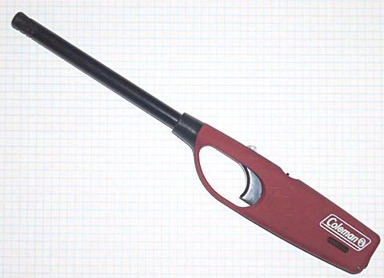 |
|
Once you have the lighter open remove the barrel and any other extra parts. Now locate the two wires that supplied the high voltage to the tip of the barrel. In this particular lighter, one of the wires runs inside the fuel supply hose. The other wire was connected to the metal barrel. |
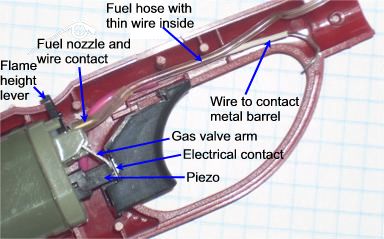 |
|
I soldered a short length of wire to the barrel wire and covered the joint with heat shrink tubing (electrical tape would work fine). I routed the wire and wire-in-hose through the front of the lighter, reassembled the lighter and used epoxy to the wire and wire-in-hose in place. The epoxy plug also seals the back of the combustion chamber (film canister). Be careful that you don't collapse the gas supply tube. Hot melt glue might work in place of epoxy, but you should first check that the heat does not melt or collapse the fuel supply hose. For the image at right I carefully pulled the case back open after the epoxy had cured. |
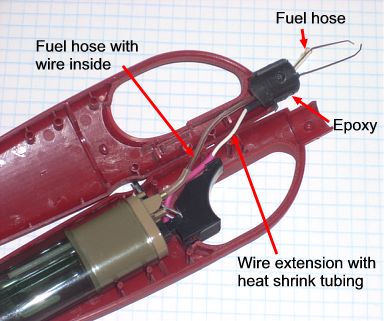 |
|
Drill a suitably sized hole (mine was 1/2") in the lid of the film canister so that the front of the lighter body fits through it snugly. Slide the lid over the end of the lighter. Bend the ends of the two wires to form a 2 to 3 mm spark gap (~1/10 inch). The spark gap must be a half inch or so away from the end of the fuel hose. If the spark is too close it will ignite the fuel during fueling, which we don't want. |
 |
|
To fire the popper: 1. Push the film canister securely onto the canister lid. Be careful not to bend the spark gap wires. 2. Pull and hold the trigger for about three seconds to inject butane into the film canister. The actual time needed will vary depending on the lighter and the setting of the lighter's flame height adjuster (if it has one). You will have to determine the correct length of time by trial and error. If the gun does not fire remove the canister and blow fresh air into it before trying again. 3. Wait for about five seconds to give the butane time to mix with the air in the canister. 4. Point in a safe direction and pull the trigger. |
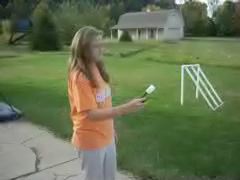
(Click the image for a short movie. Because of the video compression the sound is out of sync with the video.) |
The popper launches the canister with a fair amount of force. If it hits a person at point blank range it will hurt.
The canister won't fly very far because it is too light for its size.
1. If you put too much or too little fuel in the popper it won't fire. The flammability limits of butane in air is about 2% to 8% (by volume) butane. More than 8% (or less than 2%) will not ignite.
2. Check that the lighter is actually supplying butane to the canister. You can invert the front of the popper (without the film canister attached) into a cup of water and pull the trigger. You should see a steady stream of bubbles coming out of the fuel hose. Make sure you dry off the spark wires before trying to use the popper.
3. Check that there is a spark at the spark gap. The gap can't be too big or the spark won't jump it. Two or three millimeters (1/10" ~ 1/8") is about right. If the spark gap is too small it also won't work. The spark can be hard to see in bright light so check it in dim light. If there is no spark then check that the spark wire inside the fuel hose reaches all the way down to the fuel nozzle on the butane cartridge.
Combustion
Complete combustion of butane (C4H10)
in air
(~21% O2, 79% nitrogen) produces carbon dioxide
(CO2)
and water as described by the equation:
2 C4H10 + 13 O2 = 8 CO2 + 10 H2O + heat
The equation tells us that for each 13 molecules of oxygen we need 2 molecules of butane. Since air is only ~21% oxygen we need (21%)(2/13) = 3.23% by volume butane in the combustion chamber.
The 35mm film canister measures approximately 1.15" diameter by 1.9" long so the volume of the canister is about 2 cubic inches (32cc). Since we need 3.23% butane in the canister the volume of butane required for complete combustion is (2in3)(0.0323) = 0.0646in3 (1.06cc).
Butane in air will only burn if the percentage of butane is in the range of 1.9% to 8.4%. Outside that range the mixture can not be ignited.
Performance
Below are three frames from a video of the popper being fired. In
the first frame the canister is still on the popper. In the
second frame the canister is a blur located about a foot from the
popper. In the third frame the popper is about 3 feet from the popper.
Using the video frame rate of 30
frames per second, and
the estimate of how far the canister has moved between the second and
third frames as 1.8 feet, we can estimate the velocity of the
canister: (1.8 feet)(30 frames/second) = 54 feet/second.
